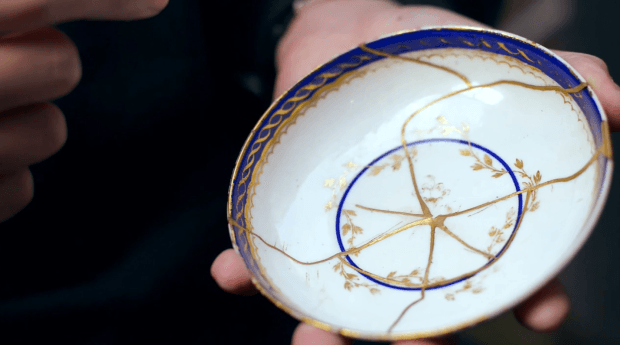More Beautiful Broken: Eight and the Art Form of Kintsugi
Admittedly, it is hard to wrap one's mind around the fact that such a beautiful pure heart like the Eighth Doctor's is so broken and worn down due to trauma over time. And yet, even in his brokenness, he still manages to help, still wants to be of assistance. He's always trying to prove to himself and others that he is still a good man, still "the Doctor" in the purest sense. In his aching weakness and relatable sorrow, he grows more poignant and lovely as a character.
Because of this, I liken the Eighth Doctor's character development to the Japanese art form of kintsugi.
What Is Kintsugi?

This technique, literally translated as "golden joinery" (also called kintsukuroi, "to repair with gold"), involves putting broken pottery back together with an epoxy or lacquer dusted with precious metals, such as gold, silver, or even platinum. In so doing, the artist accentuates the traumatic history of the piece and transforms the chaotic mess of spiderweb-like cracks into a shining artistic pattern. Kintsugi artists take pieces that would ordinarily be considered too far gone to save, meant for the garbage heap, and give them new life. It fits in well with the Japanese philosophy of wabi-sabi, finding beauty and value in old and broken things; when restored this way, kintsugi pieces are considered "better than new."
Kintsugi of the Soul
One could argue that the art form of kintsugi has a spiritual/mental/emotional analog; as we each experience trauma and hardships, we collect a variety of scars, cracks, and even breaks. Our childlike selves thus become irreparably damaged and sometimes appear lost beneath years of old wounds and scar tissue. We install defense mechanisms and craft public images for ourselves to disguise and hide the damage to ourselves, or we run from it, pretending it's not there, until it inevitably catches up with us. But when we face our damage, acknowledge what has happened to us, and resolve to seek healing, we make the first step toward performing "kintsugi of the soul" on ourselves: we pay attention to those cracks and scars.
But that is not where this technique ends; while we heal, we paint each broken piece with precious spiritual metals such as compassion and forgiveness, which also serve as the "glue" that binds each piece back together. And where we have missing pieces, we fill in the gap with love. What results will not be the self we once were--it can never be. But it can be a better self, a self knitted back together with the knowledge that we are more than our failures, more than our traumas, and are still human beings worthy of love from others and especially from ourselves. This kind of self, which has known brokenness, grief, and loss, is better equipped to comfort, love, and serve those who are currently lost, broken, and grieving. This is where the precious metals in our repaired hearts truly show off their luster.
How This Fits in with Eight
Though I haven't yet experienced all of the media associated with the Eighth Doctor (audios, books, and comics), I can already see that Eight sort of does this for himself, even though he also engages in a lot of PTSD avoidance behavior. Every society/group he helps, every rescue he participates in, especially after his worst traumas, has the potential to form a new gilded seam in himself, and sometimes he takes that chance for self-growth. By the time audiences see him in "Night of the Doctor", we see a man in various states of repair, some pieces painted with gleams of metal and set back together, some pieces still lying shattered. And yet, though he's avoiding working on himself in some ways, he's also seeking out Cass to save her life, though he knows it risks his own death. This proves that not only has part of his original self survived, he's using his gained experiences to compassionately reach out and help. If that's not "kintsugi of the soul" at work, I don't know what is.



